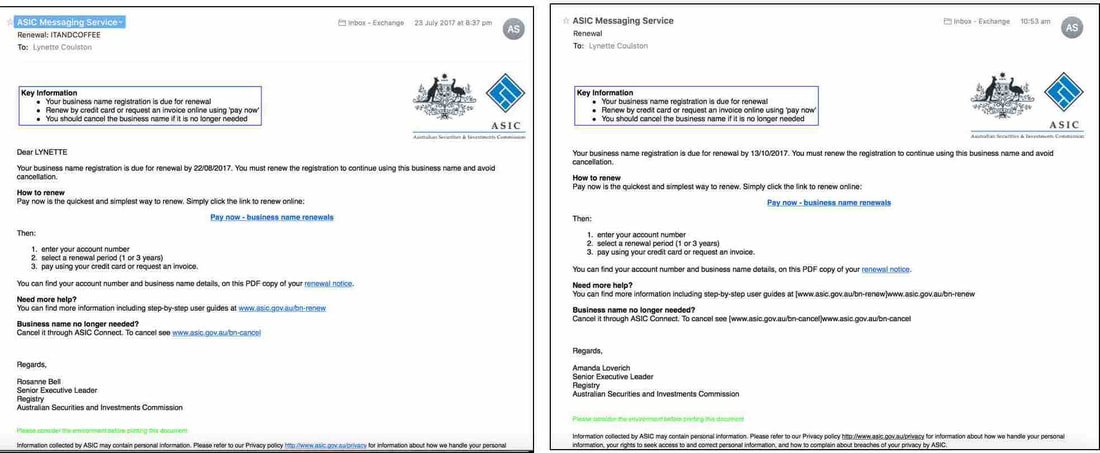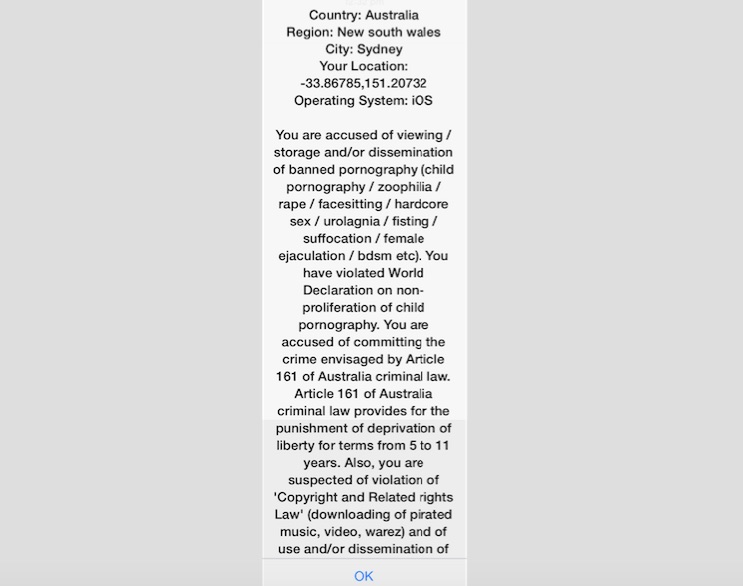|
This one nearly made me click! Have a close look at these emails (click to enlarge) and see if you can spot the differences - the things that indicate that one is a fake.
Having only recently received a real email from ASIC about the renewal of the iTandCoffee business name, I really had to look twice (and three times) at the 'same' email that I received this week. Given that I have registered two business names, my initial reaction was to believe that the email was real. Can you tell which one is real?
Working out which is legitimate
But, as I always do with any email before clicking on any links or opening/downloading any files, I had a look at who the email was from (by clicking on the email address) - and it was definitely not ASIC. The address attempted to look like an ASIC address - [email protected] - so could easily catch out many people. Another giveaway was that there was no mention of my name, or business name in the email - it seemed very generic.
I also used the 'Quick Look' feature in my Mac Mail to preview the web page associated with the 'Pay now' link. (Hover to the right of the link and click the 'down-arrow'. You can also just hover the mouse over the link to see what website it links to. On the iPad or iPhone, hold your finger on the link to see a screen that shows the link's website address at the top.)
And boy, did the preview look authentic. But the giveaway was that the website shown at the top (see the red arrow above) was NOT ASIC.
What would have happened if I 'clicked'? In fact, the 'Pay now' link did actually 'redirect' to the real ASIC website (after first taking me to the eoaclk.com website). Obviously the scammers want you be believe they are ASIC, so that you will click the 'renewal notice' link a bit further down. Clicking the 'renewal notice' link would have downloaded malware, a virus, or even ransomware - so I dared not click it on my Mac to find out which! (I could see on my iPhone that this link would have downloaded a ZIP file to the computer - I'm sure containing all sorts of 'nasties'.) Here is the article on the ASIC website, describing this scam. Be alert to scam emails like this. Always be sure the sender is legitimate before clicking any link or downloading/opening any file in an email. Do you need further help? We have a free video that demonstrates how to detect a fake email - here is the link: If you need further help in assessing whether an email is real or a fake, you can forward the email to iTandCoffee (at [email protected]) and we will check it for you to let you know if it is safe. If you are looking to learn more about your Mac, why not attend our great class series, called 'Getting to know your Mac' - check out the dates below. Become a member of The iTandCoffee Club
0 Comments
I had a call from my lovely Aunty V during the week, after the news came out about yet another 'ransomware' attack. She asked me if I could explain a term that was being used in news reports, about the need to 'patch' your computer to ensure that you are protected against attacks. What does 'patching' mean?Microsoft, Apple, Google (i.e. Alphabet) are constantly working on the software that runs our computers and mobile devices (know as operating systems), to ensure that evil-doers cannot gain access to our devices and lives via the internet. Microsoft's computer operating system is Windows. Apple's computer operating system is OS X or, more recently, MacOS. Apple mobile devices run iOS, and many other mobile devices run Google's Android operating system. All of these operating systems are, at times, targeted by hackers who try to find 'holes' in the security of these system, so that they can sneak in and steal stuff from computers that run the operating system - or even (in the case of ransomware) scramble all the information that is on the computer so that we can no longer use it. (I'll leave you to read up about ransomware in this article from Wikipedia: Ransomware - Wikipedia.) Most commonly, it is Windows that is the target of such attacks (as has been the case with the last two highly publicised 'ransomware' attacks). Microsoft, Apple and Google have, in most cases, already 'patched' the hole in their operating system security, and 'released' that patch as an 'update' to our computers' operating systems. Any computer on which the 'patch' is installed is protected if you, inadvertently, click on a nasty link or file in an email or on a website that might have otherwise taken advantage of the security hole. Are you patched?On some computers and mobile devices, these updates (patches) are automatically installed. The problem is that many computers have not been 'patched' because the business or individual user of the computer has not installed the updates that have been made available. This has left them at risk of falling victim to the ransomware attacks that seem to be getting more and more frequent. How to check and how to patchThe big question is how do you 'patch' your computer or device. To help you with this, we have included some 'how to' articles about below, that will (hopefully) help you ensure your computer or mobile device is up to date with all 'patches'. We are here to help if you need assistanceWe know that for many of our clients and subscribers, the information provided in the above articles will still leave them unsure how to proceed.
If you need assistance with this area, iTandCoffee is available for one-on-one appointments at the shop in High Street Glen Iris, or in your own home (depending on location). Over-the-phone support can also be provided if required. Just call 1300 885 420 or email [email protected] to make an appointment.  Just in case you missed all the reports in the press last week, thousands of Windows computers worldwide were impacted by a ransomware attack. The ransomware was able to infect computers on a network when any user clicked on a suspect link or downloaded an infected file that they received in an email. Here is as article about this attack: WannaCrypt: what you need to know about the global ransomware cyber attack An important thing to note is that the computers that were impacted were those that were not running the latest update to Windows. (Mac computers were not impacted by this attack, nor were Apple mobile devices or Android devices.) Microsoft had already patched the vulnerability that the attackers took advantage of, and released the security update in March. So anyone whose computer was up to date would have been protected. The big question is: How up to date is your own version of Windows? Are you safe from attacks such as this? It might be time to check, and ensure that you install the latest update - and also check that you have current anti-virus protection from Windows Defender or a third-party product. Contact iTandCoffee on 1300 885 420 if you need to make an appointment for assistance with this.  An iTandCoffee client contacted iTandCoffee this week after receiving an extremely concerning message on her iPad. She wrote: "I am sending you a snap shot of my iPad screen showing a pop notice that I have now received twice which renders my Safari inexcessable unless I action the okay option at the bottom, which then brings up some slightly alarming boxes." This message is a form of Ransomware, a scam designed to force you to pay money to fraudsters and perhaps even give away your credit card details. If you click OK on a Windows or Android computer, you may find your device has been locked up by a virus, asking you to pay the 'ransom' in order to 'release' your device. In actual fact, all that is required in this case is the removal of the virus - here are articles on how to do this on Android and Windows. Fortunately for this iTandCoffee client, the message came up on her iPad - so clicking OK did not have had any ill effects, other than to give a big fright. (This is just one of the great advantages of Apple devices - scams like this do not work on iPads and iPhones.) But this client was still 'stuck' by the message in Safari, as it seemed to have 'hijacked' her Safari and was stopping her from getting to any other functions in Safari. How to deal with scams that 'lock up' your Safari on your iPad or iPhoneIt is quite easy to resolve such a problem - by resetting your Safari browsing history and website data.
Go to Settings -> Safari and tap on Clear History and Website Data Once you have done this, you will find that you can start up a fresh Safari session that is free of the fraudster's message. |
What's on at iTandCoffee ?Below is our list of videos, classes and other events that are coming up soon.
Videos shown are offered for eligible members of the iTandCoffee Club. If you have questions, why not join fun and informative 'user group' meetings, held once a month. All iTandCoffee classes are run as online classes (using Zoom), which means you can attend from anywhere.
�
|
27 Sycamore St, Camberwell, Victoria Australia
Call +61 444 532 161 or 1300 885 320
to book an appointment or class, or to enquire about our services and products
|
SENIORS CARD WELCOME HERE:
Seniors Card holders qualify for a 10% discount on all classes booked and paid for online (excludes PTT sessions and classes already discounted during COVID-19 crisis). To activate the discount at the time of booking, select Redeem Coupon or Gift Certificate and enter 10OFFSEN before selecting Pay Now. |
© 2012-2024 iTandCoffee Pty Ltd. All rights reserved ACN: 606 340 434











